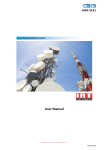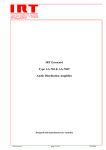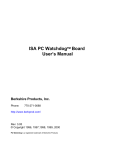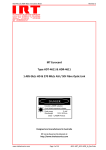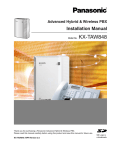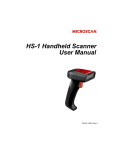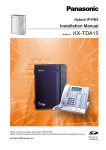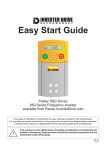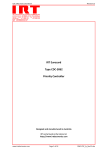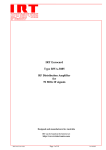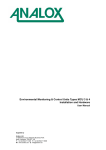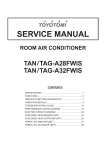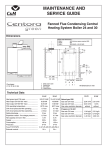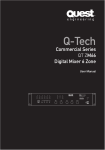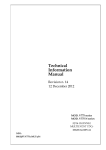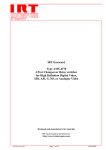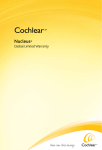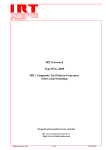Download User Manual - IRT Communications
Transcript
I R T Electronics Pty Ltd A.B.N. 35 000 832 575 26 Hotham Parade, ARTARMON N.S.W. 2064 AUSTRALIA National: Phone: (02) 9439 3744 Fax: (02) 9439 7439 International: +61 2 9439 3744 +61 2 9439 7439 Email: [email protected] Web: www.irtelectronics.com IRT Eurocard Types AAA-3130 Stereo Audio Distribution Amplifier 3130-aaa.ib.rev14.doc Page 1 of 18 06/07/2006 IRT Eurocard Types AAA-3130 Stereo Audio Distribution Amplifier Instruction Book Table of Contents Section Page General Description Technical Specifications Internal Adjustments Configuration Installation Front & rear panel connector diagrams Sub-modules AAO-3130 FACTS stereo oscillator CAA-3130 Remote mode & phase control CAA-3132 Dual remote control Maintenance & storage Warranty & service Equipment return Drawing index 3 4 5 5 6 8 9 9 12 15 17 17 17 18 This instruction book applies to units later than S/N 9801000. 3130-aaa.ib.rev14.doc Page 2 of 18 06/07/2006 General Description The IRT AAA-3130 is a high performance audio distribution amplifier. Its features allow standardisation on one ADA type to perform many functions with consequent overall cost savings. The AAA-3130 can be used for either mono or stereo signals. Inputs and outputs are balanced connector types, which can be wired for unbalanced operation, if needed, for duplicating applications. Front panel access is provided for the gain adjustment of Left and Right channels from zero output to the maximum of the selected gain range. LED’s on the front panel indicate the presence of audio on each channel and balanced output jacks are provided for front panel monitoring. Optional plug in sub-boards may be fitted to suit special applications: AAO-3130: FACTS stereo oscillator module. Left continuous & right interrupted with remote ADA/oscillator control switching. CAA-3130: Remote select Stereo/L+R/L-mono/R-mono and L-phase reversal control module. CAA-3132: Remote L&R gain, balance, stereo/mono and phase control module. Applications: • • • • Stereo signal duplication and distribution. Level matching and balancing. Stereo/mono switching. Inline tone generation. Standard features: • • • • • • • • • • Selectable stereo or mono mode. Balanced inputs and outputs Front panel monitoring jacks. LED audio activity indicators. Front panel gain adjustments. Optional remote control. Optional in line stereo tone generator. Selectable gain ranges: +6 dB, +12 dB & +18 dB. Maximum output level +24 dBu. Extended bandwidth option for ACS or timecode. 3130-aaa.ib.rev14.doc Page 3 of 18 06/07/2006 Technical Specifications IRT Eurocard module Type AAA-3130 Inputs: Left/Mono and Right Type Impedance Maximum input level Input CMR Tranformerless, balanced, bridging. > 10 kΩ. +24 dBu (6 dB gain mode) > 55 dB 20 Hz to 20 kHz Outputs: Main: (Located on rear assembly.) Type Number Impedance Maximum output level Maximum output loading DC on output Transformerless, balanced. 10 (10 mono or 5 L and 5 R). < 40 Ω. +24 dBu into 600 Ω. 10 x 600 Ω or up to 26 High Z. < ±20 mV. Monitoring: (Located on front panel.) Type Number Impedance Maximum output level Minimum output load DC on output Transformerless, balanced. 2 (L and R) 3.5 mm. < 70 Ω. +24 dBu into 600 Ω. 1 kΩ. < ±20 mV. Indicators: Audio activity 2 front panel LED's set for +4 dBu @ 1 KHz. (user adjustable). Performance: Gain Frequency response Harmonic distortion Noise Crosstalk; Left/right Amplifier/amplifier Internally linked to a maximum gain of +6, +12 or +18 dB. + 0/- 0.3 dB for 20 Hz to 20 kHz. < 0.005% 20 Hz to 20 KHz at +20 dBm. -110 dB, Ref. +24 dBm 20 to 20 kHz. -75 dB, 20 Hz to 20 kHz. -80 dB, 20 Hz to 20 kHz. Power Requirements: 28 Vac CT (14-0-14) or ± 16 Vdc. Power consumption <5 VA. Connectors: Phoenix plugable screw block. 3130 (standard) Other: Temperature range Mechanical Finish: Front panel Rear assembly Dimensions Supplied accessories: 0 - 50° C ambient. Suitable for mounting in IRT 19" rack chassis with input, output and power connections on the rear panel. Grey, black lettering & red IRT logo. Detachable silk-screened PCB with direct mount connectors to Eurocard and external signals. 6 HP x 3 U x 220 mm IRT Eurocard. ZAA-3130 rear connector assembly with Phoenix plugable compression screw terminals. Matching connectors for audio inputs & outputs supplied. Due to our policy of continuing development, these specifications are subject to change without notice. 3130-aaa.ib.rev14.doc Page 4 of 18 06/07/2006 Internal Adjustments Factory settings: The following adjustable resistors are factory set and should not be adjusted unless a component has been changed. They are not 'operational' controls. Before adjusting any of these controls allow time for the AAA-3130 to reach temperature stability. RV 1 "Left' Common Mode Rejection. Adjusted to reduce input common mode signals to a minimum at the output of the AAA-3130. RV 2 "Right' Common Mode Rejection. Adjusted to reduce input common mode signals to a minimum at the output of the AAA-3130. User settings: Audio activity indicators: RV 5 "Left & Right" Level detector threshold. RV 5 is located on the reverse side of the main PCB. To access this control it is necessary to remove the shield plate from the DA. After adjustment, the shield plate must be replaced to preserve the inter-module crosstalk noise characteristics. Note that RV5 sets the threshold level for both channels. Detector threshold point is measured at the output of the DA. This setting may be adjusted to a value consistent with normal operating level. Factory setting is +4 dBu @ 1 KHz. Maximum gain: Left channel Right channel LK 8 set as designated on PCB overlay for +6, 12 or 18 dB max. LK 7 set as designated on PCB overlay for +6, 12 or 18 dB max. See also Configuration and Installation sections following. Configuration The AAA-3130 may be configured for several modes of operation including remote control and conversion to a multi output oscillator with the addition of sub-modules. This is achieved by various link settings as outlined below. The AAA-3130 is normally delivered set for stereo operation, 6 dB maximum gain on both channels and no sub modules fitted. Configuration Summary: 1. Sub-modules: 2. Stereo/mono: No sub-module Any sub-module CAA-3130 CAA-3132 AAO-3130 LK 1 & LK 2 soldered on board. Cut LK 1 & LK 2 on board. Set to stereo mode as below. Set to stereo mode as below. Set to stereo mode as below. LK 7 & LK 8 are inoperative. Stereo Mono L Input LK 3 & LK 6 installed. LK 4 not installed. LK 3, LK 4 & LK 5 installed. LK 6 not installed. LK 8 sets maximum gain. Gain adjust is only by RV 3 L gain. LK 7 and RV 4 are inoperative. LK 3, LK 5, & LK 6 installed. LK 4 not installed LK 7 sets maximum gain. Gain adjust is only by RV 4 R gain. LK 8 and RV 3 are inoperative. Mono R Input 3130-aaa.ib.rev14.doc Page 5 of 18 06/07/2006 Installation Operational Safety: WARNING Operation of electronic equipment involves the use of voltages and currents that may be dangerous to human life. Note that under certain conditions dangerous potentials may exist in some circuits when power controls are in the OFF position. Maintenance personnel should observe all safety regulations. Do not make any adjustments inside equipment with power ON unless proper precautions are observed. All internal adjustments should only be made by suitably qualified personnel. All operational adjustments are available externally without the need for removing covers or use of extender cards. Pre-installation: Handling: This equipment may contain or be connected to static sensitive devices and proper static free handling precautions should be observed. Where individual circuit cards are stored, they should be placed in antistatic bags. Proper antistatic procedures should be followed when inserting or removing cards from these bags. Power: AC mains supply: Ensure that operating voltage of unit and local supply voltage match and that correct rating fuse is installed for local supply. DC supply: Ensure that the correct polarity is observed and that DC supply voltage is maintained within the operating range specified. Earthing: The earth path is dependent on the type of frame selected. In every case particular care should be taken to ensure that the frame is connected to earth for safety reasons. See frame manual for details. Signal earth: For safety reasons a connection is made between signal earth and chassis earth. No attempt should be made to break this connection. 3130-aaa.ib.rev14.doc Page 6 of 18 06/07/2006 Installation in frame or chassis: See details in separate manual for selected frame type. Audio Connections: For mono operation it is usual to connect the input audio cable to the Left input pins. For stereo connect the Left input cable to the Left input and the Right input audio cable to the Right input. The input and output connectors are 3 way balanced Phoenix connectors. Where an unbalanced connection is required, the signal may be connected between either the + input and GND or the – input and GND. On the input only the unused input pin should be connected directly to GND. Do not ground the unused output pin, as this will damage the amplifier. 3130-aaa.ib.rev14.doc Page 7 of 18 06/07/2006 Front & rear panel connector diagrams The following front panel and rear assembly drawings are not to scale and are intended to show relative positions of connectors, indicators and controls only. AAA -3 1 3 0 3130 L O/P’s R O/P’s + + Gnd Gnd + + Gnd Gnd + + Gnd Gnd + + Gnd Gnd + + L GAIN R L MON. R L Gnd Gnd Remote R 1234 DC + + Gnd Gnd LEFT & MONO INPUT RIGHT INPUT N140 3130-aaa.ib.rev14.doc Page 8 of 18 06/07/2006 IRT Eurocard Sub-module Type AAO-3130 General Description The AAO-3130 Four frequency switched stereo oscillator sub-module converts the supporting main module audio distribution amplifier into a multi output reference stereo oscillator for test or alignment purposes. Right channel can be set-up for either pulsed (interrupted every second) or continuous operation. This configuration conforms to the recommended practice of FACTS (Federation of Australian Commercial Television Stations) for channel identification. Provision is made to remotely switch the frequency to a fixed 40 Hz, 400 Hz, 1 kHz or 10 kHz tone. Technical Specifications IRT Eurocard Sub-module Type AAO-3130 Control input: Remote switch component Connections: Single pole 4 position or equivalent (Not supplied) On rear assembly of main module 4 pin female polarised IDC # 1300-104 GND Relay 1 control Relay 2 control Relay 3 control (Oscillator On) Pin 1 2 3 4 Performance: (See main module specifications for other specifications) Distortion Frequency < 0.01% at + 8 dBm. Remote selectable to: 40 Hz, 400 Hz, 1 kHz or 10 kHz. Power requirements: ± 12 Vdc from main module See main module specifications Power consumption Other: Temperature range Dimensions Standard accessories 0 - 50° C ambient 65 mm x 48 mm Matching connector for control input type: 1300-104 Optional accessories Instruction manual. 3130-aaa.ib.rev14.doc Page 9 of 18 06/07/2006 Circuit Description The circuit comprises of a low distortion Wein bridge oscillator, an astable multivibrator and a voltage controlled switch with a remote control facility to select the operating frequency. The oscillator output is passively split with one output fed directly to the left output. The other output is fed via an FET which is gated on and off by a square wave oscillator to provide an output which is alternatively on and off. This if fed to the right output. The gating frequency may be trimmed by adjusting potentiometer RV 1 which sets the frequency of the astable multivibrator U 2. The normal input circuitry of the distribution amplifier is bypassed when the oscillator is switched in by relay RL3. Control of frequency is by way of grounding contacts, which activate relays, RL1 and RL2, on the sub-board to select the correct time constants in the circuit. These are arranged so that four commonly used frequencies may be obtained using only two control relays operated over a three-wire circuit. The circuit does not contain a latch for the remote input and the external contact must therefore be maintained for as long as the selected frequency is required. In the absence of any remote input both relays will turn off and the oscillator will default to 400 Hz. RL3 must be switched on for the oscillator output to be switched to the main board outputs. With RL3 switched off, the main board functions as a normal audio distribution amplifier. Configuration Before installing the AAO-3130, on the main board, AAA-3130, cut the on board links LK1 and LK2. Ensure the main board is set for stereo operation as outlined in AAA-3130 the main module section. For pulsed tone on right channel, on AAO-3130 sub-board, set link settings to LK1 closed and LK2 open. For continuous tone on right channel, on AAO-3130 sub-board, set link settings to LK1 open and LK2 closed. Left channel always remains as a continuous tone. Installation Module To install the sub-module onto the main module first ensure that the proper mode of operation has been selected on both the main and sub-modules. Then remove straps LK 1 and LK 2 on the main module. Hold the sub-module so that the legends on the sub-board and the legends on the main module have the same orientation. Place the sub-module over the connector pins of the main module. The 16 pins fit into 16 holes in the sub-module. Push the sub-board down until it rests on the orange insulation of the pins. 3130-aaa.ib.rev14.doc Page 10 of 18 06/07/2006 Operation Remote control of frequency To switch in the oscillator, relay RL3 must be switched on. This is done by connecting pins 1 and 4 on the 4 pin header on the rear connector of the main module’s rear connector unit. The frequency of the oscillator may be set using pins 2 and 3 connected to pin 1 of the remote connector on the rear assembly of the main module. If no connection is made the oscillator will default to 400 Hz operation. 1 2 3 4 As the remote switches and wiring carry the full relay current it is important that the losses in the external wiring be kept to a minimum. Refer to Drawing 804213 for modes of operation. Frequency 40 Hz 400 Hz 1 kHz 10 kHz 3130-aaa.ib.rev14.doc Connect to Pin 1 (GND) 2 Default N/C 2&3 3 Page 11 of 18 06/07/2006 IRT Eurocard Sub-board Type CAA-3130 General Description The CAA-3130 can remotely switch between mono and stereo modes or reverse the phase of the left channel in stereo mode. Links on the board allow a choice of either a -3 dB or -6 dB mono mix (Only one mode is possible at any time). 1. 2. 3. 4. Normal stereo operation. Reverse phase of left channel Switch left channel input to mono output. Mix left and right channels to mono output with selectable 3 dB or 6 dB cut in signal level. Technical Specifications IRT Eurocard Sub-module Type CAA-3130 Control input: Remote gain component Connections: (Not supplied) On rear assembly of main module 3 pin female polarised IDC # 1300-103-426 GND Relay 1 control Relay 2 control Pin 1 2 3 Performance: (See main module specifications for other specifications) Operation modes Frequency Response Distortion Noise Attenuation mono mix mode Power requirements: Power consumption Other: Temperature range Dimensions Standard accessories Optional accessories 3130-aaa.ib.rev14.doc Remote selectable: (Only one mode is possible at any time) Stereo (normal) Invert left channel phase Mono output from left input Mix of stereo input to mono output +0 / -0.5 dB 20 Hz to 20 KHz. < 0.1% at +20 dBm. -100 dB wrt +24 dBm. -3 dB or -6 dB selectable by links. ± 12 Vdc from main module See main module specifications 0 - 50° C ambient 65 mm x 48 mm Matching connector 1300-103-426 for control input type: Instruction manual. Page 12 of 18 06/07/2006 Circuit Description The CAA-3130 is comprised of a single operational amplifier in series with the left channel audio whose gain is determined by four relays which determine the path and thereby the amplitude of the signals in the circuit. With no relays activated the amplifier functions as a voltage follower and has no effect on the phase or gain of either channel. When RL 1 is activated the input to U 1 is switched from the non-inverting to the inverting input resulting in a phase reversal of the left channel signal. When RL 2 is activated the right channel output is switched from the right input to the left output and both left and right channels receive the signal from the left channel input of the main module. In this mode the right channel input of the main module is disconnected from the circuit and gain control link LK 7 on the main board will have no effect. When both RL 1 & RL 2 are activated simultaneously the right output signal is derived from the left output as described above. However in this case the right and left input signals are also switched to the inverting input of U 1 and summed via resistors R 1, R 3, R 5 & R 6 which determine the gain of the resultant mono mix. Links LK 1 & LK 2 are provided to bypass resistors R 3 & R 6 respectively. Both links should either be installed or removed. Operation with only one link installed will result in the gain of the two channels not being matched under some circumstances. With the links installed the gain is unity for each signal with an overall result of +6 dB for the resultant mix. With LK 1 & LK 2 removed the input signal from each channel is attenuated and the overall gain for each signal is reduced to 0.71 resulting in a +3 dB mix. Note that if the links are removed for the +3 dB mix option, that operation of RL 1 on its own to provide phase reversal of the left channel will also result in a 1.5 dB attenuation of the left channel when the phase is reversed. Configuration The main module must first be configured to accept the sub-module. This is achieved by various link settings as outlined in the main module manual. The main module is normally delivered set for stereo operation and no sub-modules fitted. Before installing the CAA-3130 check that the main module is set to stereo mode as detailed in main module instruction manual. Installation Module To install the sub-module onto the main module first ensure that the proper mode of operation has been selected on both the main and sub-modules. Then remove straps LK 1 and LK 2 on the main module. Hold the sub-module so that the legends on the sub-board and the legends on the main module have the same orientation. Place the sub-module over the connector pins of the main module. The 16 pins fit into 16 holes in the sub-module. Push the sub-board down until it rests on the orange insulation of the pins. 3130-aaa.ib.rev14.doc Page 13 of 18 06/07/2006 Remote control CAA-3130 can be remotely switched to provide one of the following modes of operation (Only one mode is possible at any time). 1. Normal stereo operation. 2. Reverse phase of left channel 3. Switch left channel input to mono output. 4. Mix left and right channels to mono output with selectable 3 dB or 6 dB cut in signal level. To configure these options see Drawing 803013. To control the operation mode a switch should be wired between the pins marked Remote "1", "2" and "3" on the RB-733 rear assembly. Pin connections are: Pin 1 common ground Pin 2 relay 1 control Pin 3 relay 2 control The CAA-3130 is supplied with two links LK 1 & LK 2 bridging resistors R3 and R6 respectively. This configuration sets the gain to -6 dB in stereo to mono mix mode. To change attenuation in this mode to -3 dB remove links LK 1 & LK 2. 3130-aaa.ib.rev14.doc Page 14 of 18 06/07/2006 IRT Eurocard Sub-board Type CAA-3132 General Description This plug-in option for selected IRT audio distribution amplifiers can be configured to provide any two of the following modes of operation: • • • • STEREO FADE over 75 dB range STEREO TRIM of 6 dB CROSS FADE over 75 dB or 6 dB range MIX L+R & FADE both by up to 75 dB. Only two modes of operation are possible at the same time. Technical Specifications IRT Eurocard Sub-module Type CAA-3132 Control input: Remote gain component 10 KΩ potentiometer (Not supplied) One required for each of the two functions. On rear assembly of main module 4 pin female polarised IDC # 1300-104-426 CCW connection of the potentiometers (GND) Rotor for first gain element CW connection of the potentiometers (1 KΩ in series with + 12 Vdc) Rotor for second gain element. Connections: Pin 1 2 3 4 Performance: (See main module specifications for other specifications) Frequency Response Harmonic Distortion Noise Attenuation Power requirements: Power consumption +0 / -0.5 dB 20 Hz to 20 KHz. < 0.1% 20 Hz to 20 KHz at +20 dBm. -94 dB, Ref. +24 dBm 20 Hz to 20 KHz. > 75 dB.( Measurement for stereo fade mode ) ± 12 Vdc from main module See main module specifications Other: Temperature range Dimensions Standard accessories 0 - 50° C ambient 65 mm x 48 mm Matching connector 1300-104-426 Optional accessories Instruction manual. 3130-aaa.ib.rev14.doc Page 15 of 18 for control input type: 06/07/2006 Circuit Description The circuit uses a TDA1074A variable gain control IC to perform the configured function. Configuration is by means of resistors that determine the function as shown on diagram 804141. As received from the factory the first element is set to Stereo Trim and the second element to Stereo Balance. The input control circuits are isolated from the signal path and use DC controls which are filtered by the combinations of R 2, C 1 & R4, C7 to provide immunity to noise, either in the external wiring or in the operation of the external potentiometers. The operating range is determined by the type of cable used and the degree of noise in the environment. For best results over long distances a low loss screened cable should be used and the route carefully chosen to avoid proximity to high level noise sources. For short distances flat IDC ribbon cable will suffice. Configuration The main module must first be configured to accept the sub-module. This is achieved by various link settings as outlined in the main module manual. The main module is normally delivered set for stereo operation and no sub-modules fitted. Before installing the CAA-3132 set the main module to stereo mode as detailed in main module instruction manual. The CAA-3132 can be configured to provide any two of the following modes of operation:1. Stereo Fade Up to 75 dB attenuation on both channels simultaneously. 2. Trim As above, but range limited to 6 dB. 3. Cross Fade Fade down left, fade up right/ fade down right, fade up left. Up to 75 dB range. 4. Balance As above but range limited to 6 dB. 5. Mix L+R & Fade Add left to right and fade both by up to 75 dB. To configure these options see Drawing 804141. Installation Module To install the sub-module onto the main module, first ensure that the proper mode of operation has been selected on both the main and sub-modules. Then remove straps LK 1 and LK 2 on the main module. Hold the sub-module so that the legends on the sub-board and the legends on the main module have the same orientation. Place the sub-module over the connector pins of the main module. The 16 pins fit into 16 holes in the sub-module. Push the sub-board down until it rests on the orange insulation of the pins. Remote control To control the two gain elements two remote 100 KΩ variable resistor should be wired between the pins of J3 on the main module rear assembly marked Remote “1”, “2” and “3”, for the first element and “1”, “4” and “3” for the second element. Connect Pin 1 to the bottom of both potentiometers (CCW connection) Pin 2 to the slider of the second element potentiometer (rotor connection) (Trim) Pin 3 to the top (CW connection). Pin 4 to the slider of the first element potentiometer (rotor connection) (Balance) 3130-aaa.ib.rev14.doc Page 16 of 18 06/07/2006 Maintenance & storage Maintenance: No regular maintenance is required. Care however should be taken to ensure that all connectors are kept clean and free from contamination of any kind. This is especially important in fibre optic equipment where cleanliness of optical connections is critical to performance. Storage: If the equipment is not to be used for an extended period, it is recommended the whole unit be placed in a sealed plastic bag to prevent dust contamination. In areas of high humidity a suitably sized bag of silica gel should be included to deter corrosion. Where individual circuit cards are stored, they should be placed in antistatic bags. Proper antistatic procedures should be followed when inserting or removing cards from these bags. Warranty & Service Equipment is covered by a limited warranty period of three years from date of first delivery unless contrary conditions apply under a particular contract of supply. For situations when “No Fault Found” for repairs, a minimum charge of 1 hour’s labour, at IRT’s current labour charge rate, will apply, whether the equipment is within the warranty period or not. Equipment warranty is limited to faults attributable to defects in original design or manufacture. Warranty on components shall be extended by IRT only to the extent obtainable from the component supplier. Equipment return: Before arranging service, ensure that the fault is in the unit to be serviced and not in associated equipment. If possible, confirm this by substitution. Before returning equipment contact should be made with IRT or your local agent to determine whether the equipment can be serviced in the field or should be returned for repair. The equipment should be properly packed for return observing antistatic procedures. The following information should accompany the unit to be returned: 1. 2. 3. 4. 5. 6. 7. A fault report should be included indicating the nature of the fault The operating conditions under which the fault initially occurred. Any additional information, which may be of assistance in fault location and remedy. A contact name and telephone and fax numbers. Details of payment method for items not covered by warranty. Full return address. For situations when “No Fault Found” for repairs, a minimum charge of 1 hour’s labour will apply, whether the equipment is within the warranty period or not. Contact IRT for current hourly rate. Please note that all freight charges are the responsibility of the customer. The equipment should be returned to the agent who originally supplied the equipment or, where this is not possible, to IRT direct as follows. Equipment Service IRT Electronics Pty Ltd 26 Hotham Parade ARTARMON N.S.W. 2064 AUSTRALIA Phone: Email: 3130-aaa.ib.rev14.doc 61 2 9439 3744 [email protected] Page 17 of 18 Fax: 61 2 9439 7439 06/07/2006 Drawing index Unless otherwise specified all references on diagrams to AA-604 or AA-704 refer equally to the AAA-3130. Drawing # Sheet # Description 804137 804137 1 2 AAA-3130 stereo audio distribution amplifier main circuit schematic AAA-3130 stereo audio distribution amplifier audio monitoring circuit schematic 804213 804388 804141 3130-aaa.ib.rev14.doc AAO-3130 Switched frequency stereo oscillator sub-board CAA-3130 Remote control sub-board CAA-3132 Remote control sub-board Page 18 of 18 06/07/2006 29b SK1-3 31a J3-4 SK2-1 29a SK2-3 J4 R11 100k R15 100k R1 100k R5 100k 4R7 FS4 4R7 FS3 4R7 FS2 4R7 FS1 C6 330p R12 5k6 C7 330p C1 330p R2 5k6 C2 330p - - U1A +12V R13 5k6 R16 5k6 -12V U2A 1N4004 NE5532 NE5532 D5-D8 + + D1-D4 -12V 1N4004 3 2 3 2 +12V R3 5k6 1 1 NOTE : WHEN USING ZAA-3130M SHORT THE FOLLOWING RESISTORS = R37,38,55,56 : FOR PCB ISS3 SHORT LINKS 9 TO 11 26a/b 25a/b 23a/b 24a/b 22a/b 21a/b 30a SK2-2 + RIGHT 27a 28b J3-3 28a J3-2 J3-1 30b + LEFT 31b SK1-2 SK1-1 8 - + 4 8 - + 4 C16 1500u C15 1500u R14 5k6 RV2 500R R4 5k6 RV1 500R 6 5 6 5 C18 1u C17 1u R20 1k R10 1k 7912 U6 2 7812 U5 1 I I C21 0.1u NE5532 U2B +12V R8 1k R18 1k O 7 7 O R36 10R NE5532 R19 2k2 U1B R9 2k2 3 3 -12V +12V C5 100u 6dB 12dB 18dB C3 0.1u D9 BAT85 C8 0.1u C10 100u 6dB 12dB 18dB LK7 -12V +12V LK8 1 2 R6 5k6 G 2 G 1 C20 10u C31 C30 -12V 4x 100n -12Va +12V -12Vb C33 +12Vb C32 -12V +12V -12V 3 3 4 6 8 7 5 2 LK2 LK1 PL3 2 4 6 1 8 7 5 PL2 +12V +12Va C19 10u GAIN GAIN L4 L3 L2 L1 -12V -12V LD1 (GR) D10 16V R58 1K -12Vb +12Vb -12Va +12Va RV4 4k7 +12V +12V RV3 4k7 1 2 LK6 S M LK5 M LK4 LK3 S -12Va C12 220u +12Va R59 100k R28 220R R29 2k2 R60 100k R21 220R U3A C14 220u NE5532 -12Vb U4B C13 22p NE5532 +12Vb -12Vb NE5532 R30 10k U3B U4A C11 22p NE5532 -12Va +12Vb R33 4k7 5 6 3 2 R26 4k7 5 6 3 2 R23 10k +12Va 8 + 4 0 + 0 8 + 4 0 + 0 D12 D16 D18 7 D17 1 D15 D14 7 D13 1 D11 -12Vb R76 3k9 R73 3k9 +12Vb -12Vb R72 3k9 R69 3k9 +12Vb -12Va R68 3k9 R65 3k9 +12Va -12Va R64 3k9 R61 3k9 +12Va D11-D18 1N4148 2 12 1 2 12 1 2 12 1 2 12 1 R22 2k2 R77 18R R31 10k SIZE R54 Q3 2N2905A CONTRACT No. ENG. APP. CHECKED DRAWN COPYRIGHT DO NOT COPY NOR DISCLOSE TO ANY THIRD PARTY WITHOUT WRITTEN CONSENT -12Vb Q7 2N2905A C28 100p C.M. LK9 3a/b 7a/b 11a/b 15a/b 19a/b 18a 14a 10a 6a 2a 17a 13a 9a 5a 1a 18b 14b 10b 6b 2b 17b 13b 9b 5b 1b AAA-3130 804137 AMPLIFIER SHEET 1 OF 2 SK4 -1 SK6 -1 SK8 -1 SK10-1 SK12-1 SK4 -2 SK6 -2 SK8 -2 SK10-2 SK12-2 SK3 -1 SK5 -1 SK7 -1 SK9 -1 SK11-1 SK3 -2 SK5 -2 SK7 -2 SK9 -2 SK11-2 AUDIO DISTRIBUTION SHT 2 DRAWING No. TITLE R81 33 R56 SHT 2 LK10 SHT 2 LK12 C29 100p SHT 2 LK11 IRT Electronics Pty. Ltd. ARTARMON NSW AUSTRALIA 2064 SCALE A3 R48 R75 R52 R44 4R7 4R7 R40 R74 Q8 2N2219A +12Vb R32 10k R55 Q5 2N2905A R80 33 R51 -12Vb R47 4R7 R43 4R7 R71 R39 R70 Q6 2N2219A +12Vb R79 33 R50 4R7 -12Va R46 R42 4R7 R67 R38 R66 Q4 2N2219A +12Va C23 22p R53 Q1 2N2905A R25 10k R49 4R7 C22 22p R45 R63 R78 33 R41 4R7 -12Va R37 R24 10k R37 - R56 18R R62 Q2 2N2219A +12Va C27 22u C26 22u C25 22u C24 22u 1 02/12/97 2 21/07/98 ECR1009 3 23/07/99 R79 R78 R80 R103 10K R100 100 -12 +12 S1 100 RV5 2K R102 12K R101 S2 5 4 6 7 +12 U7B LM339 3 -12 U7A + 12 2 1 -12 +12 -12 +12 C100 100n R104 1M C101 100n R105 1M R107 10K R106 1K -12 +12 +12 9 8 10 11 U7D U7C 0 + C102 1u 0 R81 -12 14 13 C103 1u R108 R109 3K3 3K3 1 1 LD LD3 LD LD2 2 2 +12 +12 1 02/12/97 CONTRACT No. ENG. APP. CHECKED DRAWN COPYRIGHT DO NOT COPY NOR DISCLOSE TO ANY THIRD PARTY WITHOUT WRITTEN CONSENT C.M. AAA-3130 804137 AMPLIFIER AUDIO DISTRIBUTION DRAWING No. TITLE IRT Electronics Pty. Ltd. ARTARMON NSW AUSTRALIA 2064 SCALE A3 SIZE SHEET 2 OF 2 400Hz 40Hz 10KHz 1KHz STATIC RL1 ON RL2 ON RL1&2 ON FREQ RL2 C3 2n2 CONTROL 3 5 C2 6n8 C1 390p R3 390K 5 R1 390K R4 47K 3 10 8 RL1 RL1 D3 BAS32L R19 10K C7 100n R2 47K C4 390p 6n8 C5 2n2 2 1 1 -V 12 RL3 Q2 J108 R5 330R 100n CD9 U1 +V RA53 TH1 3 2 100n CD8 10 470K R6 7 -V 4 5 6 1 8 12 TL081 RL2 D1 BAS32L t 1 2 RL1 1 t R7 75R TH2 1K0 4K7 R8 +V CD3 100n +12 D2 BAS32L 5K RV1 CD2 22u 12 RL2 1 CD1 22u U2 1 2 4 6 -V 100n CD4 C8 1u 6 7 R18 330K RV2 1M LK2 -V TL081 6 1 7 100n CD7 3 2 100n 4K7 +V R10 1K8 CONTROL PL1 RIGHT 3 CD6 LEFT 5 +12V R9 6 7 8 4R7 R20 -12V 7 4 5 C6 1 2 8 -12 THD DIS 2M7 R17 LK1 R16 4K7 R14 4K7 R12 10K 10K R11 -V TR O/P U3 R15 3K9 Q1 2N4392 TLC555 5 4R7 4 RST CV -V PL2 8 V+ GND 1 R21 CD5 100n 2 3 C9 10n R13 3K9 10 3 RL3 8 7 5 6 3 RIGHT CONTRACT No. ENG. APP. CHECKED DRAWN COPYRIGHT DO NOT COPY NOR DISCLOSE TO ANY THIRD PARTY WITHOUT WRITTEN CONSENT = LK2 CLOSED, LK1 OPEN AAO-3130 804213 STEREO OSCILLATOR DRAWING No. TITLE IRT Electronics Pty. Ltd. ARTARMON NSW AUSTRALIA 2064 SCALE A3 SIZE 2) TONE CONTINUOUS ON THE RIGHT CHANNEL = LK1 CLOSED, LK2 OPEN PL1 5 LEFT 1) TONE PULSED ON RIGHT CHANNEL 1 10/6/1995 ECR964 2 19/01/99 ECR1055 3 08/12/99 ECR1074 4 14/01/00 SHEET 1 OF 1 PC804214 REMOTE J3 RB-733 4 3 2 1 AAA-3130 PCB 804389 P1/24b P1/28a P1/27a P1/28b C10+ C5+ PL1/3 PL2/3 PL1/2 PL1/1 PL2/2 PL2/1 RIGHT CHANNEL PL1/4 LEFT CHANNEL PL1/5 PL2/4 PL2/5 PL1/6 PL1/7 PL2/7 PL2/6 PL1/8 PL2/8 AAA-3130 R1 12K R3 12 1 10 10 3 RL2B 7 88 7 RL3B 10 12K R8 12K 12K R5 R6 9 6 5 R9 C9 C8 R7 RL3 ON RL2+RL3 ON RL1+RL2+RL3 ON J3/1 - J3/4 J3/1 - J3/3 and J3/4 J3/1 - J3/2 + J3/3 + J3/4 WITH 'L' PHASE REVERSAL STEREO TO MONO MIX STEREO TO MONO MIX RIGHT CHANNEL MONO LEFT CHANNEL MONO RL2 ON J3/1 - J3/3 STEREO OPERATION LEFT CHANNEL PHASE INVERT AND REMOVE SOLDER LINKS LK1 AND LK2 ON THE AAA-3130 BOARD. TL074 U1C 12K 22pF 22pF 12K TL074 8 7 C6 100nF U1B +12V -12V ENABLE STEREO OPERATION BY CLOSING LINKS LK3 AND LK6, 10 D1 1N4148 BEFORE FITTING THE STEREO CONTROL MODULE RL1B RL1A RL1 ON 7 8 6 5 C3 100nF RL1 46ND012-P 12 1 +12V STATIC NOTE: 14 1 TL074 U1D 22pF C5 -12V TL074 U1A 1 2 J3/1 - J3/2 12 13 3 2 12K +12V 22pF R2 D2 1N4148 RL2 46ND012-P 12 1 NO CONNECTION 12K R4 12K 1 2 C4 D3 1N4148 4 11 1 2 RL3 46ND012-P C7 100nF 5 6 6 10R R10 RL2A C1 10uF R11 10R 02-02-2000 Date: K.N. 1-Feb-2001 Revision: 1 ENG. APP. CHECKED PL2/3 PL2/4 LEFT CHANNEL PL2/5 PL2/6 PL2/7 PL2/8 Drawing No. 804388 Sheet 1 of 1 STEREO CONTROL MODULE CAA-3130 RV4 Top RV3 Top +12V -12V IRT Electronics Pty. Ltd. ARTARMON NSW AUSTRALIA 2064 SCALE N.T.S. A3 Title PL3/1 PL2/1 SIZE PL3/2 PL3/3 PL3/4 PL3/5 PL3/6 PL3/7 PL3/8 AAA-3130 PL2/2 RIGHT CHANNEL 3 DO NOT COPY NOR DISCLOSE TO ANY THIRD PARTY WITHOUT WRITTEN CONSENT COPYRIGHT 35 DRAWN RL3A C2 10uF 1 10K 6K8 10K 10K AUDIO OVER MIX L+R + FADE TRIM BALANCE 15K R12 10K 10K SC 10K 10K SC 22K 22K OC 33K OC OC RD 6K8 15K R8 R13 6K8 RC +12 OC OC 6K8 OC OC OC RE C1 47u C2 100n R9 R2 27K R1 1K NOTE: RB & RG ARE ALWAYS 10K 10K CROSS FADE RA 10K 1 2 3 4 5 STEREO FADE RIGHT IN LEFT IN 7 RC2 6 8 PL1 RC3 RF 22K 10K 10K 10K 10K 10K RH 10K 10K 10K 10K 10K SC R3 1K 10K 22K 10K 10K 10K OC RJ 16 15 3 4 8 9 R7 OC OC OC 10K 10K OC RK R11 R10 18 U1 1 10K U1 10K 10K U1 10K R6 11 +12 17 2 C3 100u 10 R5 1K 22u C9 22u C8 C7 47u R4 27K RJ RF RK RE RD RA 10K 22K O/C O/C 22K 10K +12 13 14 6 5 C4 100u 10K U1 10K RH 10K U1 RG 10K RC RB 12 7 1 05/11/97 1 2 3 4 RIGHT OUT LEFT OUT PWR GND 6 5 +12V IN 7 PL2 CONTRACT No. ENG. APP. CHECKED DRAWN COPYRIGHT DO NOT COPY NOR DISCLOSE TO ANY THIRD PARTY WITHOUT WRITTEN CONSENT 22u C6 22u C5 +12 8 CAA-3132 804141 SUB-BOARD REMOTE CONTROL DRAWING No. TITLE IRT Electronics Pty. Ltd. ARTARMON NSW AUSTRALIA 2064 SCALE A3 SIZE SHEET 1 OF 1























